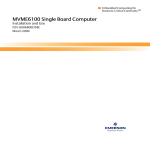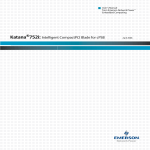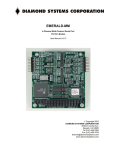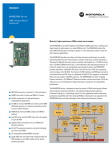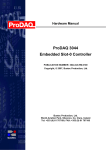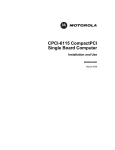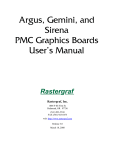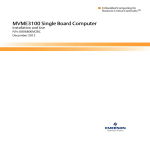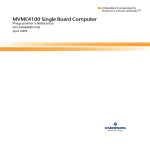Download Emerson MVME6100 Film Camera User Manual
Transcript
MVME6100 Single-Board Computer Programmer’s Reference Guide V6100A/PG1 July 2004 Edition © Copyright 2004 Motorola Inc. All rights reserved. Printed in the United States of America. Motorola and the stylized M logo are trademarks of Motorola, Inc., registered in the U.S. Patent and Trademark Office. All other product or service names mentioned in this document are the property of their respective owners. Safety Summary The following general safety precautions must be observed during all phases of operation, service, and repair of this equipment. Failure to comply with these precautions or with specific warnings elsewhere in this manual could result in personal injury or damage to the equipment. The safety precautions listed below represent warnings of certain dangers of which Motorola is aware. You, as the user of the product, should follow these warnings and all other safety precautions necessary for the safe operation of the equipment in your operating environment. Ground the Instrument. To minimize shock hazard, the equipment chassis and enclosure must be connected to an electrical ground. If the equipment is supplied with a three-conductor AC power cable, the power cable must be plugged into an approved three-contact electrical outlet, with the grounding wire (green/yellow) reliably connected to an electrical ground (safety ground) at the power outlet. The power jack and mating plug of the power cable meet International Electrotechnical Commission (IEC) safety standards and local electrical regulatory codes. Do Not Operate in an Explosive Atmosphere. Do not operate the equipment in any explosive atmosphere such as in the presence of flammable gases or fumes. Operation of any electrical equipment in such an environment could result in an explosion and cause injury or damage. Keep Away From Live Circuits Inside the Equipment. Operating personnel must not remove equipment covers. Only Factory Authorized Service Personnel or other qualified service personnel may remove equipment covers for internal subassembly or component replacement or any internal adjustment. Service personnel should not replace components with power cable connected. Under certain conditions, dangerous voltages may exist even with the power cable removed. To avoid injuries, such personnel should always disconnect power and discharge circuits before touching components. Use Caution When Exposing or Handling a CRT. Breakage of a Cathode-Ray Tube (CRT) causes a high-velocity scattering of glass fragments (implosion). To prevent CRT implosion, do not handle the CRT and avoid rough handling or jarring of the equipment. Handling of a CRT should be done only by qualified service personnel using approved safety mask and gloves. Do Not Substitute Parts or Modify Equipment. Do not install substitute parts or perform any unauthorized modification of the equipment. Contact your local Motorola representative for service and repair to ensure that all safety features are maintained. Observe Warnings in Manual. Warnings, such as the example below, precede potentially dangerous procedures throughout this manual. Instructions contained in the warnings must be followed. You should also employ all other safety precautions which you deem necessary for the operation of the equipment in your operating environment. Warning Warning To prevent serious injury or death from dangerous voltages, use extreme caution when handling, testing, and adjusting this equipment and its components. Flammability All Motorola PWBs (printed wiring boards) are manufactured with a flammability rating of 94V-0 by UL-recognized manufacturers. EMI Caution Caution ! Caution This equipment generates, uses and can radiate electromagnetic energy. It may cause or be susceptible to electromagnetic interference (EMI) if not installed and used with adequate EMI protection. Lithium Battery Caution This product contains a lithium battery to power the clock and calendar circuitry. Caution ! Caution Caution ! Attention Caution ! Vorsicht Danger of explosion if battery is replaced incorrectly. Replace battery only with the same or equivalent type recommended by the equipment manufacturer. Dispose of used batteries according to the manufacturer’s instructions. Il y a danger d’explosion s’il y a remplacement incorrect de la batterie. Remplacer uniquement avec une batterie du même type ou d’un type équivalent recommandé par le constructeur. Mettre au rebut les batteries usagées conformément aux instructions du fabricant. Explosionsgefahr bei unsachgemäßem Austausch der Batterie. Ersatz nur durch denselben oder einen vom Hersteller empfohlenen Typ. Entsorgung gebrauchter Batterien nach Angaben des Herstellers. CE Notice (European Community) Warning ! Warning This is a Class A product. In a domestic environment, this product may cause radio interference, in which case the user may be required to take adequate measures. Motorola Computer Group products with the CE marking comply with the EMC Directive (89/336/EEC). Compliance with this directive implies conformity to the following European Norms: EN55022 “Limits and Methods of Measurement of Radio Interference Characteristics of Information Technology Equipment”; this product tested to Equipment Class A EN55024 “Information technology equipment—Immunity characteristics—Limits and methods of measurement” Board products are tested in a representative system to show compliance with the above mentioned requirements. A proper installation in a CE-marked system will maintain the required EMC performance. In accordance with European Community directives, a “Declaration of Conformity” has been made and is available on request. Please contact your sales representative. Notice While reasonable efforts have been made to assure the accuracy of this document, Motorola, Inc. assumes no liability resulting from any omissions in this document, or from the use of the information obtained therein. Motorola reserves the right to revise this document and to make changes from time to time in the content hereof without obligation of Motorola to notify any person of such revision or changes. Electronic versions of this material may be read online, downloaded for personal use, or referenced in another document as a URL to the Motorola Computer Group Web site. The text itself may not be published commercially in print or electronic form, edited, translated, or otherwise altered without the permission of Motorola, Inc. It is possible that this publication may contain reference to or information about Motorola products (machines and programs), programming, or services that are not available in your country. Such references or information must not be construed to mean that Motorola intends to announce such Motorola products, programming, or services in your country. Limited and Restricted Rights Legend If the documentation contained herein is supplied, directly or indirectly, to the U.S. Government, the following notice shall apply unless otherwise agreed to in writing by Motorola, Inc. Use, duplication, or disclosure by the Government is subject to restrictions as set forth in subparagraph (b)(3) of the Rights in Technical Data clause at DFARS 252.227-7013 (Nov. 1995) and of the Rights in Noncommercial Computer Software and Documentation clause at DFARS 252.227-7014 (Jun. 1995). Motorola, Inc. Computer Group 2900 South Diablo Way Tempe, Arizona 85282 Contents About This Guide Overview of Contents ................................................................................................xiv Comments and Suggestions ......................................................................................xiv Conventions Used in This Manual .............................................................................xv CHAPTER 1 Board Description and Memory Maps Introduction .............................................................................................................. 1-1 Overview .................................................................................................................. 1-1 Memory Maps .......................................................................................................... 1-5 Default Processor Memory Map ....................................................................... 1-5 MOTLoad’s Processor Memory Map ............................................................... 1-7 Default PCI Memory Map ................................................................................ 1-8 MOTLoad’s PCI Memory Maps ....................................................................... 1-9 VME Memory Map ........................................................................................... 1-9 System I/O Memory Map ................................................................................. 1-9 System Status Register 1 ................................................................................. 1-11 System Status Register 2 ................................................................................. 1-13 System Status Register 3 ................................................................................. 1-15 Presence Detect Register ................................................................................. 1-16 Configuration Header/Switch Register (S1) ................................................... 1-17 Time Base Enable Register ............................................................................. 1-19 Quad Universal Asynchronous Receiver/Transmitter (UART) ....................... 1-19 Real-Time Clock and NVRAM ...................................................................... 1-20 CHAPTER 2 Programming Details Introduction .............................................................................................................. 2-1 MV64360 Multi-Purpose Port Configuration .......................................................... 2-1 MV64360 Reset Configuration ................................................................................ 2-3 Flash Memory .......................................................................................................... 2-8 Real-Time Clock and NVRAM ................................................................................ 2-8 Two-Wire Serial Interface ........................................................................................ 2-9 DDR DRAM Serial Presence Detect ..................................................................... 2-10 MV64360 Initialization .......................................................................................... 2-11 VPD and User Configuration EEPROMs .............................................................. 2-11 vii Temperature Sensor ................................................................................................ 2-11 MV64360 Device Controller Bank Assignments ................................................... 2-11 MPC Bus and PCI Bus Arbitration ......................................................................... 2-12 PCI Bus 0 and PCI Bus 1 Local Buses ................................................................... 2-12 PCI Mode/Frequency Selection ....................................................................... 2-12 PCI Configuration Space ................................................................................. 2-13 PCI Arbitration Assignments for MV64360 ASIC ......................................... 2-14 PCI Bus 1 Local Bus PMC Expansion Slots ................................................... 2-14 PCI Bus 0 Local Bus Devices ......................................................................... 2-15 Tsi148 ASIC ............................................................................................. 2-15 PCI6520 PMCSpan Bridge ...................................................................... 2-15 MV64360 Interrupt Controller ............................................................................... 2-16 MV64360 Endian Issues ......................................................................................... 2-18 APPENDIX A Related Documentation Motorola Computer Group Documents ................................................................... A-1 Manufacturers’ Documents ..................................................................................... A-2 Related Specifications ............................................................................................. A-5 viii List of Figures Figure 1-1. MVME6100 Board Layout Diagram ................................................... 1-4 Figure 2-1. PCI Bus 1 Local Bus PMC Expansion Slots ...................................... 2-15 ix List of Tables Table 1-1. MVME6100 Features Summary ............................................................ 1-2 Table 1-2. Default Processor Address Map ............................................................. 1-5 Table 1-3. MOTLoad’s Processor Address Map ..................................................... 1-7 Table 1-4. Default PCI Address Map ...................................................................... 1-8 Table 1-5. MOTLoad’s PCI Memory Maps ............................................................ 1-9 Table 1-6. Device Bank 1 I/O Memory Map ......................................................... 1-10 Table 1-7. System Status Register 1 ...................................................................... 1-11 Table 1-8. System Status Register 2 ...................................................................... 1-13 Table 1-9. System Status Register 3 ...................................................................... 1-15 Table 1-10. Presence Detect Register .................................................................... 1-16 Table 1-11. Configuration Header/Switch Register .............................................. 1-17 Table 1-12. TBEN Register ................................................................................... 1-19 Table 1-13. M48T37V Access .............................................................................. 1-20 Table 2-1. MV64360 MPP Pin Function Assignments ........................................... 2-2 Table 2-2. MV64360 Power-Up Configuration Settings ......................................... 2-4 Table 2-3. M48T37V Access .................................................................................. 2-9 Table 2-4. I2C Bus Device Addressing ................................................................. 2-10 Table 2-5. Device Bank Assignments ................................................................... 2-12 Table 2-6. IDSEL Mapping for PCI Devices ........................................................ 2-13 Table 2-7. PCI Arbitration Assignments for MV64360 ASIC .............................. 2-14 Table 2-8. MV64360 Interrupt Assignments ......................................................... 2-16 Table A-1. Motorola Computer Group Documents ................................................A-1 Table A-2. Manufacturers’ Documents ...................................................................A-2 Table A-3. Related Specifications ...........................................................................A-5 xi About This Guide The MVME6100 Single-Board Computer Programmer’s Reference Guide provides general programming information, including memory maps, interrupts, and register data for the MVME6100 family of boards. This document should be used by anyone who wants general, as well as technical information about the MVME6100 products. As of the printing date of this manual, the MVME6100 supports the models listed below. Model Number Description MVME6100-0161 1.267 GHz MPC7457 processor, 512MB DDR memory, 128MB Flash, Scanbe handles MVME6100-0163 1.267 GHz MPC7457 processor, 512MB DDR memory, 128MB Flash, IEEE handles MVME6100-0171 1.267 GHz MPC7457 processor, 1GB DDR memory, 128MB Flash, Scanbe handles MVME6100-0173 1.267 GHz MPC7457 processor, 1GB DDR memory, 128MB Flash, IEEE handles xiii Overview of Contents This manual is divided into the following chapters and appendices: Chapter 1, Board Description and Memory Maps, provides a brief product description and a block diagram. The remainder of the chapter provides information on memory maps and system and configuration registers. Chapter 2, Programming Details, provides additional programming information including IDSEL mapping, interrupt assignments for the MV64360 interrupt controller, flash memory, two-wire serial interface addressing, and other device and system considerations. Appendix A, Related Documentation, provides a listing of related Motorola manuals, vendor documentation, and industry specifications. Comments and Suggestions Motorola welcomes and appreciates your comments on its documentation. We want to know what you think about our manuals and how we can make them better. Mail comments to: Motorola Computer Group Reader Comments DW164 2900 S. Diablo Way Tempe, Arizona 85282 You can also submit comments to the following e-mail address: [email protected] In all your correspondence, please list your name, position, and company. Be sure to include the title and part number of the manual and tell how you used it. Then tell us your feelings about its strengths and weaknesses and any recommendations for improvements. xiv Conventions Used in This Manual The following typographical conventions are used in this document: bold is used for user input that you type just as it appears; it is also used for commands, options and arguments to commands, and names of programs, directories and files. italic is used for names of variables to which you assign values, for function parameters, and for structure names and fields. Italic is also used for comments in screen displays and examples, and to introduce new terms. courier is used for system output (for example, screen displays, reports), examples, and system prompts. <Enter>, <Return> or <CR> represents the carriage return or Enter key. Ctrl represents the Control key. Execute control characters by pressing the Ctrl key and the letter simultaneously, for example, Ctrl-d. xv 1Board Description and Memory Maps 1 Introduction This chapter briefly describes the board level hardware features of the MVME6100 single-board computer, including a table of features and a block diagram. The remainder of the chapter provides memory map information including a default memory map, MOTLoad’s processor memory map, a default PCI memory map, MOTLoad’s PCI memory map, a PCI I/O memory map, and system I/O memory maps. Note Programmable registers in the MV64360 system controller are documented in a separate publication and obtainable from Motorola Computer Group by contacting your Field Area Engineer. Refer to Appendix A, Related Documentation, for more information on obtaining this documentation. Overview The MVME6100 is a single-board computer based on the PowerPC MPC7457 processor, the Marvell MV64360 system controller, up to 2 GB of ECC-protected DDR DRAM, up to 128MB of Flash memory, a dual Gigabit Ethernet interface, two asynchronous serial ports, and two IEEE1386.1 PCI, PCI-X capable mezzanine card slots (PMCs). 1-1 1 Board Description and Memory Maps The following table lists the features of the MVME6100. Table 1-1. MVME6100 Features Summary Feature Description Processor – Single 1.3 GHz MPC7457 processor – Bus clock frequency at 133 MHz – 36-bit address, 64-bit data buses – Integrated L1 and L2 cache L3 Cache – 2MB using DDR SRAM – Bus clock frequency at 211 MHz Flash – Two banks (A & B) of soldered Intel StrataFlash devices – 8 to 64MB supported on each bank – Boot bank is switch selectable between banks – Bank A has combination of software and hardware write-protect scheme – Bank B top 1MB block can be write-protected through software/hardware write-protect control System Memory – Two banks on board for up to 2GB using 256Mb or 512Mb devices – Bus clock frequency at 133 MHz Memory Controller PCI Host Bridge Dual 10/100/1000 Ethernet Interrupt Controller PCI Interface I2C Interface – Provided by Marvell MV64360 system controller NVRAM Real-Time Clock Watchdog Timer – 32KB provided by MK48T37 On-board Peripheral Support – Dual 10/100/1000 Ethernet ports routed to front panel RJ-45 connectors, one optionally routed to P2 backplane – Two asynchronous serial ports provided by an ST16C554D; one serial port is routed to a front panel RJ-45 connector and the second serial port is optionally routed to the P2 connector for rear I/O or on-board header 1-2 Computer Group Literature Center Web Site Overview Table 1-1. MVME6100 Features Summary (continued) Feature Description PCI/PMC – Two 32/64-bit PMC slots with front-panel I/O plus P2 rear I/O as specified by IEEE P1386 – 64-bit slots; 33/66 MHz PCI or 66/100 MHz PCI-X VME Interface – Tsi148 VME 2Esst ASIC provides: ❏ Eight programmable VMEbus map decoders ❏ A16, A24, A32, and A64 address ❏ 8-bit, 16-bit, and 32-bit single cycle data transfers ❏ 8-bit, 16-bit, 32-bit, and 64-bit block transfers ❏ Supports SCT, BLT, MBLT, 2eVME, and 2eSST protocols ❏ 8 entry command and 4KB data write post buffer ❏ 4KB read ahead buffer PMCspan Support – One PMCspan slot – Supports 33/66 MHz, 32/64-bit PCI bus – Access through PCI6520 bridge to PMCspan Form Factor – Standard 6U VME Miscellaneous – Combined reset and abort switch – Status LEDs – 8-bit software-readable switch – VME geographical address switch http://www.motorola.com/computer/literature 1-3 1 1 Board Description and Memory Maps J42 J8 J7 U17 J29 PCI MEZZANINE CARD J21 J22 J23 J24 U19 U16 P1 U27 U25 U23 U22 U11 U15 J11 J12 U10 U14 PCI MEZZANINE CARD U9 U21 U30 U18 J3 PMC IPMC U8 U13 J30 U20 U7 U6 J13 J14 LAN 1 J9 LAN 2 10/100/1000 10/100/1000 U5 J93 U4 U3 U32 U12 P2 DEBUG J19 U1 ABT/RST J4 4248 0504 Figure 1-1. MVME6100 Board Layout Diagram 1-4 Computer Group Literature Center Web Site Memory Maps Memory Maps Default Processor Memory Map The MV64360 presents a default CPU memory map following RESET negation. The following table shows the default memory map from the point of view of the processor. Address bits [35:32] are only relevant for the MPC7457 extended address mode and are not shown in the following tables. (Note that it is the same as the GT-64260A with the addition of integrated SRAM.) Table 1-2. Default Processor Address Map Processor Address Notes Start End Size Definition 0000 0000 007F FFFF 8M DRAM Bank 0 0080 0000 00FF FFFF 8M DRAM Bank 1 0100 0000 017F FFFF 8M DRAM Bank 2 0180 0000 01FF FFFF 8M DRAM Bank 3 0200 0000 0FFF FFFF 224M Unassigned 1000 0000 11FF FFFF 32M PCI Bus 0 I/O Space 1200 0000 13FF FFFF 32M PCI Bus 0 Memory Space 0 1400 0000 1BFF FFFF 128M Unassigned 1C00 0000 1C7F FFFF 8M Device CS0* 1C80 0000 1CFF FFFF 8M Device CS1* 1D00 0000 1DFF FFFF 16M Device CS2* 1E00 0000 1FFF FFFF 32M Unassigned 2000 0000 21FF FFFF 32M PCI Bus 1 I/O 2200 0000 23FF FFFF 32M PCI Bus 1 Memory Space 0 2400 0000 25FF FFFF 32M PCI Bus 1 Memory Space 1 2600 0000 27FF FFFF 32M PCI Bus 1 Memory Space 2 http://www.motorola.com/computer/literature 1-5 1 1 Board Description and Memory Maps Table 1-2. Default Processor Address Map (continued) Processor Address Notes Start End Size Definition 2800 0000 29FF FFFF 32M PCI Bus 1 Memory Space 3 2A00 0000 41FF FFFF 384M Unassigned 4200 0000 4303 FFFF 256K MV64360 Integrated SRAM 4304 0000 F0FF FFFF 2783M Unassigned F100 0000 F100 FFFF 64K Internal Registers F101 0000 F1FF FFFF 16M-64K Unassigned F200 0000 F3FF FFFF 32M PCI Bus 0 Memory Space 1 F400 0000 F5FF FFFF 32M PCI Bus 0 Memory Space 2 F600 0000 F7FF FFFF 32M PCI Bus 0 Memory Space 3 F800 0000 FEFF FFFF 112M Unassigned FF00 0000 FF7F FFFF 8M Device CS3* FC00 0000 FFFF FFFF 64M Boot Flash (Bank A or B depending on S4:3 switch setting) Note 1-6 See Note Set by configuration resistors. Computer Group Literature Center Web Site MOTLoad’s Processor Memory Map MOTLoad’s Processor Memory Map MOTLoad’s processor memory map is given in the following table. Table 1-3. MOTLoad’s Processor Address Map Processor Address Start End Size Definition 0000 0000 top_dram-1 dram_size System Memory (onboard DRAM) 8000 0000 DFFF FFFF 1536M PCI Bus 0 and/or VME Memory Space E000 0000 EFFF FFFF 256M PCI Bus 1 Memory Space F000 0000 F07F FFFF 8M PCI Bus 1 I/O Space F080 0000 F0FF FFFF 8M PCI Bus 0 I/O Space F100 0000 F10F FFFF 1M MV64360 Internal Registers F110 0000 F11F FFFF 1M Device CS1* I/O System Regs/NVRAM/RTC/UARTs F400 0000 F7FF FFFF 64M Device CS0* Flash Bank A F800 0000 FBFF FFFF 64M Device Boot Flash Bank B Note Notes See Note The internal registers only occupy the first 64KB, but minimum address decoding resolution is 1MB. http://www.motorola.com/computer/literature 1-7 1 1 Board Description and Memory Maps Default PCI Memory Map The MV64360 presents the following default PCI memory map after RESET negation. Note: it is the same as the GT-64260A with the addition of integrated SRAM. Table 1-4. Default PCI Address Map PCI Address 1-8 Start End Size Definition 0000 0000 007F FFFF 8M DRAM Bank 0 0080 0000 00FF FFFF 8M DRAM Bank 1 0100 0000 017F FFFF 8M DRAM Bank 2 0180 0000 01FF FFFF 8M DRAM Bank 3 0200 0000 0FFF FFFF 224M Unassigned 1000 0000 11FF FFFF 32M PCI Bus 1 P2P I/O Space 1200 0000 13FF FFFF 32M PCI Bus 1 P2P Memory Space 0 1400 0000 1400 FFFF 64K Internal Registers 1401 0000 1BFF FFFF 128M-64K Unassigned 1C00 0000 1C7F FFFF 8M Device CS0* 1C80 0000 1CFF FFFF 8M Device CS1* 1D00 0000 1DFF FFFF 16M Device CS2* 1E00 0000 1FFF FFFF 32M Unassigned 2000 0000 21FF FFFF 32M PCI Bus 0 P2P I/O Space 2200 0000 23FF FFFF 32M PCI Bus 0 P2P Memory Space 0 2400 0000 25FF FFFF 32M PCI Bus 0 P2P Memory Space 1 2600 0000 41FF FFFF 448M Unassigned 4200 0000 4303 FFFF 256K MV64360 Integrated SRAM 4304 0000 F1FF FFFF 2800M Unassigned Computer Group Literature Center Web Site MOTLoad’s PCI Memory Maps Table 1-4. Default PCI Address Map (continued) PCI Address Start End Size Definition F200 0000 F3FF FFFF 32M PCI Bus 1 P2P Memory Space 1 F400 0000 FEFF FFFF 176M Unassigned FF00 0000 FF7F FFFF 8M Device CS3* FC00 0000 FFFF FFFF 64M Boot Flash Bank B MOTLoad’s PCI Memory Maps MOTLoad’s PCI memory map for each PCI domain is shown in the following tables. Table 1-5. MOTLoad’s PCI Memory Maps PCI Address Start End Size Definition 0000 0000 top_dram dram_size System Memory (onboard DRAM) VME Memory Map The MVME6100 is fully capable of supporting both the PReP and the CHRP VME Memory Map examples with RAM size limited to 2 GB. System I/O Memory Map System resources including system control and status registers, NVRAM/RTC, and the 16550 UART are mapped into a 1 MB address http://www.motorola.com/computer/literature 1-9 1 1 Board Description and Memory Maps range assigned to Device Bank 1. The memory map is defined in the following table: Table 1-6. Device Bank 1 I/O Memory Map 1-10 Address Definition F110 0000 System Status Register 1 F110 0001 System Status Register 2 F110 0002 System Status Register 3 F110 0003 Reserved F110 0004 Presence Detect Register F110 0005 Software Readable Header/Switch F110 0006 Timebase Enable Register F110 0008 -F110 FFFF Reserved for onboard registers F111 0000 -F111 7FFF M48T37V NVRAM/RTC F112 0000 -F112 0FFF COM 1 UART F112 1000 -F112 0FFF COM 2 UART F112 2000 -F112 0FFF Reserved (undefined) F112 3000 -F11F FFFF Reserved (undefined) Computer Group Literature Center Web Site System Status Register 1 System Status Register 1 The MVME6100 board System Status Register 1 is a read-only register used to provide board status information. REG System Status Register 1- 0xF1100000 BIT 7 6 5 4 3 2 1 0 REF_CLK BANK_SELECT SAFE_START ABORT_L FLASH_BSY_L FUSE_STAT SROM_INIT RSVD Table 1-7. System Status Register 1 X X X 1 1 X 0 FIELD OPER R RESET X REF_CLK Reference clock. This bit reflects the current state of the 28.8 KHz reference clock derived from the 1.8432 MHz UART oscillator divided by 64. This clock may be used as a fixed timing reference. BANK_SEL Boot Flash bank select. This bit reflects the current state of the boot Flash bank select jumper. A cleared condition indicates that Flash bank A is the boot bank. A set condition indicates that Flash B is the boot bank. SAFE_START ENV safe start. This bit reflects the current state of the ENV safe start select jumper. A set condition indicates that MOTLoad should provide the user the capability to select which Boot Image is used to boot the board, cleared MOTLoad should proceed with the first boot image found. http://www.motorola.com/computer/literature 1-11 1 1 Board Description and Memory Maps ABORT_L Abort. This bit reflects the current state of the onboard abort signal. This is a debounced version of the abort switch and may be used to determine the state of the abort switch. A set condition indicates that the abort switch is not depressed while a cleared condition would indicate that the abort switch is asserted. FLASH_BSY_L FLASH Busy. This bit provides the current state of the Flash Bank A StrataFlash device Status pins. These two open drain output pins are wire ORed. Refer to the appropriate Intel StrataFlash data sheet for a description on the function of the Status pin. FUSE_STAT Fuse Status. This bit indicates the status of the onboard fuses. A cleared condition indicates that one of the fuses is open. A set condition indicates that all fuses are functional. SROM_INIT SROM Init. This bit indicates the status of the SROM Init. A cleared condition indicates that the SROM Init is disabled. A set condition indicates that the SROM Init is enabled and the MV64360 was initialized using the MV64360 User Defined Initialization SROM at $A6. 1-12 Computer Group Literature Center Web Site System Status Register 2 System Status Register 2 The MVME6100 board system status register 2 provides board control and status bits. Table 1-8. System Status Register 2 REG BIT System Status Register 2- 0xF1100001 7 6 5 4 3 2 1 0 BD_FAIL EEPROM_WP (NOT USED) FLASHA_WP TSTAT_MASK FBOOTB_WP FBA_WP_HDR FBOOTB_WP_HDR RSVD FIELD OPER R/W R R/W R/W R/W R R R RESET 1 1 1 1 1 X X X BD_FAIL Board Fail. This bit is used to control the Board Fail LED located on the front panel. A set condition illuminates the front panel LED and a cleared condition extinguishes the front panel LED. EEPROM_WP Not used on the MVME6100. FLASHA_WP Software Flash Bank A Write Protect. This bit is to provide softwarecontrolled protection against inadvertent writes to the expansion FLASH memory devices. Clearing this bit and disabling the HW write-protect will enable writes to the Bank A Flash devices. This bit is set during reset and must be reset by the system software to enable writing of the flash devices. http://www.motorola.com/computer/literature 1-13 1 1 Board Description and Memory Maps TSTAT_MASK Thermostat Mask. This bit is used to mask the DS1621 temperature sensor thermostat output. If this bit is cleared, the thermostat output will be enabled to generate an interrupt on GPP3. If the bit is set, the thermostat output is disabled from generating an interrupt. FBOOTB_WP Software Flash Bank B Boot Block Write Protect. This bit is to provide software-controlled protection against inadvertent writes to the Flash Bank B Top 1 MB (0xFFF00000) space. Clearing this bit and disabling HW write-protect will enable writes to the Bank B Flash Top 1MB boot block devices. This bit is set during reset and must be reset by the system software to enable writing of the Flash Bank B boot block. FBA_WP_HDR Hardware Flash Bank A write protect header status. Read ONLY. Hardware jumper configuration can not be overridden by the software control bit 6 in this register. FBOOTB_WP_HDR Hardware Flash Bank B Boot Block write protect header status. Read ONLY. Hardware jumper configuration can not be overridden by the software control bit 3 in this register. 1-14 Computer Group Literature Center Web Site System Status Register 3 System Status Register 3 The MVME6100 board system status register 3 provides the board software-controlled reset functions. Table 1-9. System Status Register 3 BIT 7 6 5 4 3 2 1 0 FIELD RSVD RSVD RSVD RSVD RSVD RSVD RSVD System Status Register 3- 0xF1100002 BOARD_RESET REG OPER R/W R R R R R R R RESET 0 0 0 0 0 0 0 0 BOARD_RESET Board Reset. Setting this bit will force a hard reset of the MVME6100 board. This bit will clear automatically when the board reset is complete. This bit will always be cleared during a read. http://www.motorola.com/computer/literature 1-15 1 Board Description and Memory Maps Presence Detect Register The MVME5500 board contains a presence detect register that may be read by the system software to determine the presence of optional devices. Table 1-10. Presence Detect Register 7 6 5 4 3 2 1 0 IPMC_PRSNT EREADY1 EREADY0 PCIE_PRSNT_L PMC1P_L PMC0P_L BIT Presence Detect Register - 0xF1100004 RSVD REG RSVD 1 X X X X X X X FIELD OPER R RESET X IPMC_PRSNT IPMC Module Present. If set (HIGH true), there is PMCspan module installed. If cleared, the PMCspan module is not installed. EREADY1 EREADY1. Indicates that the PrPMC module installed in PMC slot 2 is ready for enumeration when set. If cleared, the PrPMC module is not ready for enumeration. The PrPMC software must assert EREADY# for this bit to be set. The purpose of EREADY# is to provide a signaling method indicating that a non-monarch (vassal) PrPMC is ready to be enumerated. EREADY0 EREADY0. Indicates that the PrPMC module installed in PMC slot 1 is ready for enumeration when set. If cleared, the PrPMC module is not ready for enumeration. The purpose of EREADY# is to provide a signaling method indicating that a non-monarch (vassal) PrPMC is ready to be enumerated. 1-16 Computer Group Literature Center Web Site Configuration Header/Switch Register (S1) PCIE_PRSNT_L PMCspan Module Present. If set, there is no PMCspan module installed. If cleared, the PMCspan module is installed. PMC0P_L PMC Module 0 Present. If set, there is no PMC module installed in slot 0. If cleared, the PMC module is installed. PMC1P_L PMC Module 1 Present. If set, there is no PMC module installed in slot 1. If cleared, the PMC module is installed. Configuration Header/Switch Register (S1) The MVME6100 board has an 8-bit header or switch that may be read by the software. Table 1-11. Configuration Header/Switch Register BIT 7 6 5 4 3 2 1 0 FIELD CFG_6 CFG_5 CFG_4 CFG_3 CFG_2 CFG_1 CFG_0 Configuration Header/Switch Register - 0xF1100005 CFG_7 REG OPER R RESET X X X X X X X X CFG[7-0] Configuration Bits 7-0. These bits reflect the position of the switch installed in the configuration header location. A cleared condition http://www.motorola.com/computer/literature 1-17 1 1 Board Description and Memory Maps indicates that the switch is ON for the header position associated with that bit, and a set condition indicates that the switch is OFF. 1 16 1 8 CFG_7 = 0 CFG_5 = 1 CFG_6 = 1 8 7 CFG_6 = 0 CFG_4 = 1 7 6 CFG_5 = 0 CFG_3 = 1 6 5 CFG_4 = 0 CFG_2 = 1 5 4 CFG_3 = 0 CFG_1 = 1 4 3 CFG_2 = 0 CFG_0 = 1 3 2 CFG_1 = 0 16 2 CFG_0 = 0 ON 1 1 1-18 ON CFG_7 = 1 Computer Group Literature Center Web Site Time Base Enable Register Time Base Enable Register The time base enable (TBEN) register provides the means to control the processor’s TBEN input. Table 1-12. TBEN Register 7 6 5 4 3 2 1 0 RSVD RSVD RSVD RSVD RSVD TBEN1 (NOT USED) TBEN0 BIT TBEN Register - 0xF1100006 RSVD REG FIELD OPER RESET R/W 1 1 1 1 1 X X 1 TBEN0 Processor 0 time base enable. When this bit is cleared, the TBEN pin of processor 0 is driven low. When this bit is set, the TBEN pin is driven high. TBEN1 Not used on the MVME6100. Quad Universal Asynchronous Receiver/Transmitter (UART) The MVME6100 board contains one EXAR ST16C554D Quad UART device connected to the MV64360 device controller bus to provide asynchronous debug ports. The Quad UART supports up to four asynchronous serial ports of which two are used on the MVME6100. The ST16C554D is a universal asynchronous receiver and transmitter and is an enhanced UART with 16 byte FIFOs, receive trigger levels, and data rates up to 1.5 Mbps. Onboard status registers provide the user with error indications, operational status, and modem interface control. System http://www.motorola.com/computer/literature 1-19 1 1 Board Description and Memory Maps interrupts may be tailored to meet user requirements. The ST16C554DCQ64 provides constant active interrupt outputs but do not offer TXRDY/RXRDY outputs. Refer to the EXAR ST16C554D data sheet for additional information. COM 1 is an RS232 port and the TTL-level signals are routed through appropriate EIA-232 drivers and receivers to an RJ45 connector on the front panel. COM2 is also an RS232 port which is routed to an onboard planar header for rear I/O access via option inductors/resistors. Unused control inputs on COM1 and COM2 are wired active. The reference clock frequency for the QUART is 1.8432 MHz. All UART ports are capable of signaling at up to 115 Kbaud. Real-Time Clock and NVRAM The Real-Time Clock/NVRAM/Watchdog Timer is implemented using a SGS-Thompson M48T37V Timekeeper SRAM, and M4T28-BR12SH1 SnapHat battery. Refer to the M48T37V data sheets for additional programming information. Table 1-13. M48T37V Access 1-20 Address Offset Function - 0xF1110000 0x0000 - 0x5FFF Available for users 0x0100 - 0x0200 VxWorks "bootline" 0x6000 - 0x6FFF Reserved (MOTLoad expansion) 0x7000 - 0x7FEF MOTLoad use (GEVs) 0x7FF0 0 0x7FFF Real Time Block Computer Group Literature Center Web Site 2Programming Details 2 Introduction This chapter includes additional programming information for the MVME6100 single-board computer. Items discussed include: ❏ MV64360 Multi-Purpose Port Configuration on page 2-1 ❏ MV64360 Reset Configuration on page 2-3 ❏ Flash Memory on page 2-8 ❏ Real-Time Clock and NVRAM on page 2-8 ❏ Two-Wire Serial Interface on page 2-9 ❏ DDR DRAM Serial Presence Detect on page 2-10 ❏ MV64360 Initialization on page 2-11 ❏ VPD and User Configuration EEPROMs on page 2-11 ❏ Temperature Sensor on page 2-11 ❏ MV64360 Device Controller Bank Assignments on page 2-11 ❏ MPC Bus and PCI Bus Arbitration on page 2-12 ❏ PCI Bus 0 and PCI Bus 1 Local Buses on page 2-12 ❏ MV64360 Interrupt Controller on page 2-16 ❏ MV64360 Endian Issues on page 2-18 MV64360 Multi-Purpose Port Configuration The MV64360 contains a 32-bit multi-purpose port (MPP). The MPP pins can be configured as general purpose I/O pins, as external interrupt inputs, or as a specific control/status pin for one of the MV64360 internal devices. After reset, all MPP pins default to GPP pins (general purpose inputs). Software must then configure each of the pins for the desired function. The 2-1 Programming Details following table defines the function assigned to each MPP pin on the MVME6100 board. 2 Table 2-1. MV64360 MPP Pin Function Assignments MPP Pin Number Input/ Output Function 0 I COM1 /COM2 interrupts (ORed) 1 I Unused 2 I Abort interrupt 3 I RTC and thermostat interrupts (ORed) 4 I Unused 5 I IPMC761 interrupt 6 I MV64360 WDNMI# interrupt 7 I BCM5421S PHY interrupts (ORed) MPP[7:0] Interrupts 8 O PCI Bus 1 PMC slot 0 agent grant 9 I PCI Bus 1 PMC slot 0 agent request 10 O PCI Bus 1 PMC slot 1 agent grant 11 I PCI Bus 1 PMC slot 1 agent request 12 O PCI Bus 1 PMC slot 0 grant 13 I PCI Bus 1 PMC slot 0 request 14 O PCI Bus 1 PMC slot 1 grant 15 I PCI Bus 1 PMC slot 1 request MPP[15:8] PCI_1 Arbitration Request-Grant Pairs 16 I PCI Bus 1 Interrupts PCI-PMC0 INTA#, PMC1 INTC# 17 I PCI Bus 1 Interrupts PCI-PMC0 INTB#, PMC1 INTD#, 18 I PCI Bus 1 Interrupts PCI-PMC0 INTC#, PMC1 INTA# 19 I PCI Bus 1 Interrupts PCI-PMC0 INTD#, PMC1 INTB# 2-2 Computer Group Literature Center Web Site MV64360 Reset Configuration Table 2-1. MV64360 MPP Pin Function Assignments (continued) 2 MPP Pin Number Input/ Output 20 I PCI Bus 0 Interrupt PCI-VME INT 0 (Tempe LINT0#, PMCspan INT 2#) 21 I PCI Bus 0 Interrupt PCI-VME INT 1 (Tempe LINT1#, PMCspan INT 3#) 22 I PCI Bus 0 Interrupt PCI-VME INT 2 (Tempe LINT2#, PMCspan INT 0#) 23 I PCI Bus 0 Interrupt PCI-VME INT 3 (Tempe LINT3#, PMCspan INT 1#) Function MPP[19:16] PCI_1 Interrupts, MPP[23:20] PCI_0 Interrupts 24 O MV64360 SROM initialization active (InitAct) 25 O Watchdog Timer Expired output (WDE#) 26 O Watchdog Timer NMI output (WDNMI#) 27 I Reserved for future device interrupt 28 O Tempe ASIC (VMEbus) grant 29 I Tempe ASIC (VMEbus) request 30 O PCI6520 (PMCspan bridge) grant 31 I PCI6520 (PMCspan bridge) request MPP[31:28] PCI_0 Arbitration Request-Grant Pairs MV64360 Reset Configuration The MV64360 supports two methods of device initialization following reset: ❏ Pins sampled on the deassertion of reset ❏ Partial pin sample on deassertion of reset plus Serial ROM initialization via the I2C bus for user defined initialization http://www.motorola.com/computer/literature 2-3 Programming Details The MVME6100 board supports both options. An onboard switch setting will be used to select the option. If the pin sample only method is selected, then states of the various pins on the device AD bus are sampled when reset is deasserted to determine the desired operating modes. The following table describes the configuration options. Combinations of pullups, pulldowns and switches are used to set the options. Some options are fixed and some are selectable at build time by installing the proper pullup/pulldown resistor. Finally, some options may be selected using an onboard switch. Each option is described in the Table 6. 2 Using the SROM initialization method, any of the MV64360 internal registers or other system components (i.e. devices on the PCI bus) can be initialized. Initialization takes place by sequentially reading 8 byte address/data pairs from the SROM and writing the 32-bit data to the decoded 32-bit address until the a data pattern matching the last serial data item register is read from the SROM (default value 0xffffffff). An 8 Kbyte EEPROM is provided onboard for this user defined initialization of the MV64360. Table 2-2. MV64360 Power-Up Configuration Settings Device AD Bus Signal Select Option Default Power-Up Setting AD[0] switch X AD[1] AD[3:2] AD[4] 2-4 Resistor Resistors Fixed 1 11 1 Description State of Bit vs. Function SROM Initialization 0 No SROM initialization 1 SROM initialization enabled DRAM Pads Calibration 0 Calibration Disabled 1 Calibration Enabled SROM Device Address 00 1010000 ($A0) 01 1010001 ($A2) 10 1010010 ($A4) 11 1010011 ($A6) 0 Internal arbiter disabled 1 Internal arbiter enabled Internal 60x Bus Arbiter Computer Group Literature Center Web Site MV64360 Reset Configuration Table 2-2. MV64360 Power-Up Configuration Settings (continued) Device AD Bus Signal Select Option Default Power-Up Setting AD[5] Resistor 1 AD[7:6] AD[8] AD[9] AD[12] AD[13] AD[15:14] AD[16] AD[17] Resistor Resistor Fixed Resistor Resistor Resistors Resistor Fixed 01 1 0 1 1 10 1 Description State of Bit vs. Function Internal Space Default Address 0 0x1400.0000 1 0xf100.0000 CPU Bus Configuration 00 60x bus mode 01 MPX bus mode 10 Reserved 11 Reserved CPU Pads Calibration 0 Calibration Disabled 1 Calibration Enabled Multiple MV64360 Support 0 Not supported 1 Supported PCI_0 Pads Calibration 0 Calibration Disabled 1 Calibration Enabled PCI_1 Pads Calibration 0 Calibration Disabled 1 Calibration Enabled BootCS* Device Width 00 8 bits 01 16 bits 10 32 bits 11 Reserved 0 Disable 1 Enable 1 Must pull high PCI Retry 1 http://www.motorola.com/computer/literature 2 2-5 Programming Details Table 2-2. MV64360 Power-Up Configuration Settings (continued) 2 Device AD Bus Signal Select Option Default Power-Up Setting AD[18] Resistor 1 AD[19] AD[21:20] AD[24:22] AD[25] AD[28:26] 2-6 Resistor Resistors Resistors Fixed Resistors 1 01 000 0 101 Description State of Bit vs. Function DRAM Clock Select 0 DRAM is running at a higher frequency than the core clock 1 DRAM is running at a same frequency as the core clock 0 DRAM address and control signals toggle on falling edge of DRAM clock 1 DRAM address and control signals toggle on rising edge of DRAM clock 00 Reserved 01 Two Pipe stages 10 Reserved 11 Three pipe stages 000 100 DRAM running in sync mode 001 111 DRAM running in async mode Gigabit port 3 Enable 0 Disable 1 Enable PCI_1 DLL control 000 DLL disable 001 Conventional PCI mode at 66MHz 101 PCI-X mode at 133 MHz 110 PCI-X mode at 66 MHz DRAM Address/Contr ol Delay DRAM control path pipeline select DRAM read path control Computer Group Literature Center Web Site MV64360 Reset Configuration Table 2-2. MV64360 Power-Up Configuration Settings (continued) Device AD Bus Signal Select Option Default Power-Up Setting AD[31:29] Resistors 101 TxD0[0] TxD1[0] Resistor Resistor 0 0 Description State of Bit vs. Function PCI_0 DLL control 000 DLL disable 001 Conventional PCI mode at 66MHz 101 PCI-X mode at 133 MHz 110 PCI-X mode at 66 MHz Gigabit port 0 GMII/PCS Select 0 MII/GMII 1 PCS Gigabit port 1 GMII/PCS Select 0 MII/GMII 1 PCS 2 WE[3:0], DP[3:0] Resistor X DRAM PLL N Divider [7:4], [3:0] TBD Refer to MV64360 Specification MV-S10061400 Rev. B (1/13/2003) page 144 for detail. MVME6100 is not using this mode. BADR[0] Resistor 1 DRAM PLL NP 1 Pull up NP BADR[1] Resistor 1 DRAM PLL HIKVCO 1 Pull down HIKVCO BADR[2] Resistor 1 DRAM PLL NP 0 PLL power down (normal operation) 1 PLL power up TBD Refer to MV64360 Specification MV-S10061400 Rev. B (1/13/2003) page 144 for detail. MVME6100 is not using this mode. TxD0[6:1] Resistor X DRAM PLL M Divider http://www.motorola.com/computer/literature 2-7 Programming Details Table 2-2. MV64360 Power-Up Configuration Settings (continued) 2 Device AD Bus Signal Select Option Default Power-Up Setting TxD0[7] Resistor 0 TxD1[1] TxD1[4:2] Resistor Resistors 0 000 Description State of Bit vs. Function JTAG Pad Calib Bypass 0 Normal Operation 1 Bypass pad calibration Core PLL Bypass 0 Normal Operation 1 Bypass the core’s PLL Core PLL Control 000 Tuning of the core PLL clock tree. Flash Memory The MVME6100 contains two banks of flash memory accessed via the Device Controller bus contained within MV64360. Each bank contains from 8MB to 64MB of 32-bit wide Boot Block flash memory provided by two 16-bit wide Intel StrataFlash devices. The Boot Bank is jumper selectable to select either flash bank as the boot bank. The jumper effectively swaps the chip selects to the two flash banks so that either bank can be used as the boot bank. The state of the jumper is readable in the BANK_SELECT bit of System Status Register 1 to properly set up the MV64360 Device Controller Bus memory maps. The boot device bank is the same as any of the other device banks except that its default address map matches the PowerPC CPU boot address (0xfff0.0100) and that its default width is sampled at reset. Real-Time Clock and NVRAM The Real-Time Clock/NVRAM/Watchdog Timer is implemented using a SGS-Thompson M48T37V Timekeeper SRAM, and M4T28-BR12SH1 SnapHat battery. Refer to the M48T37V data sheets for additional programming information. Refer to Appendix A, Related Documentation. 2-8 Computer Group Literature Center Web Site Two-Wire Serial Interface 2 Table 2-3. M48T37V Access Address Offset Function - 0xF1110000 0x0000 - 0x5FFF Available for users 0x0100 - 0x0200 VxWorks "bootline" 0x6000 - 0x6FFF Reserved (MOTLoad expansion) 0x7000 - 0x7FEF MOTLoad use (GEVs) 0x7FF0 0 0x7FFF Real Time Block Two-Wire Serial Interface A two-wire serial interface for the MVME6100 is provided by an I2C compatible serial controller integrated into the MV64360 system controller. The I2C serial controller provides two basic functions. The first function is to provide MV64360 register initialization following a reset. The MV64360 can be configured (by switch setting) to automatically read data out of a serial EEPROM following a reset and initialize any number of internal registers. In the second function, the controller is used by the system software to read the contents of the VPD and SPD EEPROMs contained on the MVME6100 to initialize the memory controller and other interfaces. For additional details regarding the MV64360 two-wire serial controller operation, refer to the MV64360 System Controller Data Sheet. See Appendix A, Related Documentation. http://www.motorola.com/computer/literature 2-9 Programming Details The following table shows the I2C devices on the MVME6100 and their assigned device IDs. 2 Table 2-4. I2C Bus Device Addressing Device Function Size Device Address (A2A1A0) I2C BUS Address Notes Memory SPD (Bank 0 and 1) 256 x 8 000b $A0 1 Memory SPD (Bank 2 and 3) 256 x 8 001b $A2 1 Reserved (PMCSpan SROM) NA 010b $A4 MV64360 User Defined Initialization 8K x 8 011b $A6 2 Configuration VPD 8K x 8 100b $A8 2 User VPD 8K x 8 101b $AA 2 Not Used NA 110b $AC Not Used NA 111b $AE DS1621 Temperature Sensor NA 011b $90 Notes 1. The SPD defines the physical attributes of each bank or group of banks, i.e. if both banks of a group are populated, they will be the same speed and memory size. 2. This is a dual address serial EEPROM (AT24C64A or equivalent). DDR DRAM Serial Presence Detect There are two onboard SPD serial EEPROMs on the MVME6100 accessible via the I2C serial interface. The first 128 bytes of each SPD contains module type, SDRAM organization, and timing parameters. 2-10 Computer Group Literature Center Web Site MV64360 Initialization MV64360 Initialization 2 Serial EEPROM devices are provided to support optional initialization of the MV64360 (enabled by the S4:4 switch). Using the SROM initialization method, any of the MV64360 internal registers or other system components; that is, devices on the PCI bus, can be initialized. Initialization takes place by sequentially reading 8 byte address/data pairs from the SROM and writing the 32-bit data to the decoded 32-bit address until the a data pattern matching the last serial data item register is read for the SROM (default value 0xffffffff). The onboard reset logic keeps the processor reset asserted until this initialization process is completed. An SROM is provided for user MV64360 initialization. VPD and User Configuration EEPROMs The MVME6100 board contains an Atmel AT24C64 or compatible Vital Product Data (VPD) EEPROM containing configuration information specific to the board. Typical information that may be present in the VPD is: manufacturer, board revision, build version, date of assembly, memory present, options present, and L3 cache information. A second AT24C64 device is available for user data storage. Temperature Sensor The MVME6100 board provides a Maxim DS1621 digital temperature sensor with an I2C Serial Bus interface. This device may be used to provide a measure of the ambient temperature of the board. MV64360 Device Controller Bank Assignments The MVME6100 board uses three of the MV64360 Device Controller banks for interfacing to various devices. The following tables define the device bank assignments and the programmable device bank timing parameters required for each of the banks used. http://www.motorola.com/computer/literature 2-11 Programming Details 2 Table 2-5. Device Bank Assignments Device Bank Data Width Function Notes 0 32 bit Bank A or Bank B Soldered FLASH 1 1 8 bit I/O Devices 2 NA Not Used 3 NA Not Used Boot 32 bit Bank A or Bank B Soldered FLASH Note 1 1. Determined by boot bank select jumper. MPC Bus and PCI Bus Arbitration The MV64360 ASIC supplies these functions. Refer to the MV64360 Data Sheet, listed in Appendix A, Related Documentation, for details. PCI Bus 0 and PCI Bus 1 Local Buses The PCI devices on the MVME6100 are: the MV64360 ASIC, the PMCspan bridge PCI6520, the Tsi148 ASIC, PMCspan slot and the PMC Slots. PCI Mode/Frequency Selection The MVME6100 PCI Bus 0 bus is be set to PCI-X and 133 MHz for maximum performance. Onboard logic drives the PCI-X initialization pattern, as defined by the PCI-X Addendum to the PCI Local Bus Specification Revision 1.0a at the rising edge of RST#. The MVME6100 dynamically determines the mode and frequency of the PCI Bus 1 (defined by the PCI-X Addendum to the PCI Local Bus 2-12 Computer Group Literature Center Web Site PCI Configuration Space Specification Revision 1.0b) at the rising edge of RST#. Onboard logic will sense the states of PCIXCAP and M66EN for all devices on the bus and select the appropriate mode and clock frequency. Software can access the MV64360 Configuration Registers to determine the PCI mode and clock frequency of PCI Bus 1 and PCI Bus 0. Refer to the MV64360 Data Sheet, listed in Appendix A, Related Documentation, for details. Voltage Input/Output (VIO) is selected on PCI Bus 1 by the position of the PMC keying pins. Both sites should be set for the same VIO; that is, keyed identically. If 5V VIO is selected, PCI Bus 1 reverts to PCI mode at 33 MHz. PCI Configuration Space The MV64360 controls all PCI configuration space access from either the CPU or PCI busses. The IDSEL assignments for MVME6100 are shown on the following table: Table 2-6. IDSEL Mapping for PCI Devices Device Number Field PCI Address Line IDSEL Connection PCI Bus 0, PCI Bus 1 0b1_0000 AD16 MV64360 ASIC PCI Bus 0,0 0b1_0100 AD22 PCI6520 PCI Bus 0 0b1_0101 AD21 Tempe VME Bridge ASIC PCI Bus 1 0b1_0100 AD20 PMC Slot 0 (SCSI controller also uses IDSEL AD20) PCI Bus 1 0b1_0101 AD21 PMC Slot 0, Secondary PCI Agent, IPMC slot PCI Bus 1 0b1_0110 AD22 PMC Slot 1 PCI Bus 1 0b1_0111 AD23 PMC Slot 1, Secondary PCI Agent PCI Bus # http://www.motorola.com/computer/literature 2-13 2 Programming Details 2 PCI Arbitration Assignments for MV64360 ASIC PCI arbitration is performed by the MV64360 ASIC. The MV64360 integrates two PCI arbiters, one for each PCI interface (PCI Bus 0/1). Each arbiter can handle up to six external agents plus one internal agent (PCI Bus 0/1 master). The internal PCI arbiter REQ#/GNT# signals are multiplexed on the MV64360 MPP pins. The internal PCI arbiter is disabled by default (the MPP pins function as general purpose inputs). Software will configure the MPP pins to function as request/grant pairs for the internal PCI arbiter. The arbitration assignments on MVME6100 are as follows: Table 2-7. PCI Arbitration Assignments for MV64360 ASIC MPP Pin Assignment PCI Master(s) 30, 31 PCI6520 (PMCspan bridge) GNT (MPP30), REQ (MPP 31) 28, 29 Tsi148 ASIC (VMEbus) GNT (MPP 28), REQ (MPP 29) 12, 13 PMC Slot 0 GNT, REQ 14, 15 PMC Slot 1 GNT, REQ 8, 9 PMC Slot 0 Secondary PCI Agent / IPMC761 GNT, REQ 10, 11 PMC Slot 1 Secondary PCI Agent GNT, REQ PCI Bus 1 Local Bus PMC Expansion Slots Two PMC slots reside on the PCI Bus 1 local bus. The presence of PMCs can be positively determined by reading System Status Register 3. The INTA#, INTB#, INTC#, and INTD# from the PMC slots are routed by the MVME6100 as follows: 2-14 Computer Group Literature Center Web Site PCI Bus 0 Local Bus Devices 2 PMC Slot 0 PMC Slot 1 INTA# INTB# INTC# INTD# GPP[16] GPP[17] INTA# INTB# INTC# INTD# GPP[18] GPP[19] MV64360 Figure 2-1. PCI Bus 1 Local Bus PMC Expansion Slots PCI Bus 0 Local Bus Devices The MV64360 PCI Bus 0 local bus contains the Tsi148 ASIC and PCI6520 PMCSpan bridge. Tsi148 ASIC The VMEbus interface is provided by the Tsi148 ASIC. Tempe is a PCI-X bus to VMEbus interface chip. While Tsi148 has many of the same features as the VMEchip2 and Universe, it includes new features and enhancements. Therefore, Tsi148 is not register compatible with the VMEchip2 or Universe chips. See the Tsi148 User’s Manual from Tundra Semiconductor listed in Appendix A, Related Documentation, for further details. PCI6520 PMCSpan Bridge The PMCSpan interface is provided by the PCI6520. PCI6520 is a PCI-Xto-PCI-X transparent bridge to interface between PMCspan bus and the local PCI0 bus. This part operates asynchronously between primary/local http://www.motorola.com/computer/literature 2-15 Programming Details PCI0 bus at 133MHz and the secondary PMCspan bus at 33 or 66 MHz. See the PLX PCI6520 Specification for further programming information. 2 MV64360 Interrupt Controller The MVME6100 uses the MV64360 interrupt controller to route internal and external interrupt requests to the CPU and the PCI bus. The MV64360 interrupt controller registers are implemented as part of the CPU interface unit in order to have minimum read latency from CPU interrupt handler. This is not backward compatible with the Discovery I implementation since the registers are placed at different offsets. The external interrupt sources will use the GPP interface to register external interrupts. The following table shows the MVME6100 interrupt assignment to MV64360 GPP pins. Table 2-8. MV64360 Interrupt Assignments GPP Group MV64360 Edge/Level Polarity Interrupt Source Notes 0 GPP[0] Level High COM1 || COM2 3 GPP[1] Level N.A. Unused, pulled high onboard 7 GPP[2] Level Low ABORT# GPP[3] Level Low RTC || Thermostat output 6 GPP[5] Level High IPMC761 interrupt 2 GPP[6] Level Low MV64360 WDNMI# interrupt GPP[7] Level Low BCM5421S PHY 1 INTR# || BCM5421S PHY 2 INTR# GPP[16] Level Low PCI-PMC 0 INTA#, PMC 1 INTC# 2 GPP[17] Level Low PCI-PMC 0 INTB#, PMC 1 INTD#, 2 2 2-16 Computer Group Literature Center Web Site MV64360 Interrupt Controller Table 2-8. MV64360 Interrupt Assignments (continued) GPP Group 3 2 MV64360 Edge/Level Polarity Interrupt Source Notes GPP[18] Level Low PCI-PMC 0 INTC#, PMC 1 INTA# 2 GPP[19] Level Low PCI-PMC 0 INTD#, PMC 1 INTB# 2 GPP[20] Level Low PCI-VME INT 0 (Tsi148 LINT0#), PMCspan INT 2 1,5 GPP[21] Level Low PCI-VME INT 1 (Tsi148 LINT1#), PMCspan INT 3 1,5 GPP[22] Level Low PCI-VME INT 2 (Tsi148 LINT2#), PMCspan INT 0 1,5 GPP[23] Level Low PCI-VME INT 3 (Tsi148 LINT3#), PMCspan INT 1 1,5 GPP[24] Reserved for SROM initialization active InitAct output GPP[25] Reserved for Watchdog Timer WDE# output GPP[26] Reserved for Watchdog Timer WDNMI# output GPP[27] Reserved for future device interrupt Notes 1. The interrupting device is addressed from the MV64360 PCI Bus 0. 2. The interrupting device is addressed from the MV64360 PCI Bus 1. 3. The interrupting device is addressed from the MV64360 Device Bus. http://www.motorola.com/computer/literature 2-17 Programming Details 4. The interrupting device is addressed from the MV64360 I2C Bus. 2 5. The mapping of VMEbus interrupt sources and Tsi148 internal interrupt sources are programmable via the Interrupt Map Registers 1 and 2 in the Tsi148 ASIC. 6. The DS1621 Digital Thermometer and Thermostat provides 9-bit temperature readings which indicate the temperature of the device. The thermal alarm output, TOUT, is active when the temperature of the device exceeds a user defined temperature TH. 7. GPP[1,4,30,31] are unused. They are resistively pulled high onboard. MV64360 Endian Issues The MV64360 supports only a big endian CPU bus. The endianess of the local memory (DDR and SRAM) is also big endian. Data transferred to/from the local memory is never swapped. The internal registers of the MV64360 are always programed in little endian. On a CPU access to the internal registers, data is byte swapped. Data swapping on a CPU access to the PCI is controlled via PCI Swap bits of each PCI Low Address register. This configurable setting allows a CPU access to PCI agents with a different endianess convention. Refer to the MV64360 Data Sheet, listed in Appendix A, Related Documentation, for additional information and programming details. 2-18 Computer Group Literature Center Web Site ARelated Documentation A Motorola Computer Group Documents The Motorola publications listed below are referenced in this manual. You can obtain electronic copies of Motorola Computer Group publications by: ❏ Contacting your local Motorola sales office ❏ Visiting Motorola Computer Group’s World Wide Web literature site, http://www.motorola.com/computer/literature Table A-1. Motorola Computer Group Documents Document Title Motorola Publication Number MVME6100 Single-Board Computer Installation and Use V6100A/IH MOTLoad Firmware Package User’s Manual MOTLODA/UM IPMC712/761 I/O Module Installation and Use VIPMCA/IH PMCspan PMC Adapter Carrier Board Installation and Use PMCSPANA/IH To obtain the most up-to-date product information in PDF or HTML format, visit http://www.motorola.com/computer/literature A-1 A Related Documentation Manufacturers’ Documents For additional information, refer to the following table for manufacturers’ data sheets or user’s manuals. As an additional help, a source for the listed document is provided. Please note that, while these sources have been verified, the information is subject to change without notice. Table A-2. Manufacturers’ Documents Document Title and Source Publication Number MPC7457 RISC Microprocessor Hardware Specification Literature Distribution Center for Motorola Telephone: 1-800- 441-2447 FAX: (602) 994-6430 or (303) 675-2150 MPC7457EC/D Rev. 1.3,3/2003 Web Site: http://ewww.motorola.com/webapp/sps/library/prod_lib.jsp E-mail: [email protected] 80A3020_MA001_02 Tsi148 PCI/X to VME Bus Bridge User Manual Tundra Semiconductor Corporation 603 March Road Ottawa, Ontario, Canada K2K 2M5 Web Site: www.tundra.com PowerPC™ Apollo Microprocessor Implementation Definition Book IV Literature Distribution Center for Motorola Telephone: 1-800- 441-2447 FAX: (602) 994-6430 or (303) 675-2150 Addendum to SC-Vger Book IV Version - 1.0 04/21/00 Web Site: http://ewww.motorola.com/webapp/sps/library/prod_lib.jsp E-mail: [email protected] MV64360 System Controller for PowerPC Processors Data Sheet MV-S100414-00C Contact your local Motorola Computer Group Field Area Engineer for Programmable Register documentation A-2 Computer Group Literature Center Web Site Manufacturers’ Documents Table A-2. Manufacturers’ Documents (continued) Document Title and Source Publication Number BCM5421S 10/100/1000BASE-T Gigabit Transceiver with SERDES Interface 5421S-DS05-D2 10/25/02 Broadcom Corporation Web Site: http://www.broadcom.com 3 Volt Intel StrataFlash Memory 28F256K3 290737 Intel Corporation Literature Center 19521 E. 32nd Parkway Aurora CO 80011-8141 Web Site: http://developer.intel.com/design/flcomp/datashts/290737.htm PCI6520 (HB7) Transparent PCIx/PCIx Bridge Preliminary Data Book PCI6520 Ver. 0.992 PLX Technology, Inc. 870 Maude Avenue Sunnyvale, California 94085 Web Site: http://www.hintcorp.com/products/hint/default.asp EXAR ST16C554/554D, ST68C554 Quad UART with 16-Byte FIFOs ST16C554/554D Rev. 3.10 EXAR Corporation 48720 Kato Road Fremont, CA 94538 Web Site: http://www.exar.com http://www.motorola.com/computer/literature A-3 A A Related Documentation Table A-2. Manufacturers’ Documents (continued) Document Title and Source Publication Number 3.3V-5V 256Kbit (32Kx8) Timekeeper SRAM M48T37V ST Microelectronics 1000 East Bell Road Phoenix, AZ 85022 Web Site: http://www.st.com/stonline/books/toc/index.htm AT24C02N AT24C64A 2-Wire Serial CMOS EEPROM Atmel Corporation San Jose, CA Web Site: http://www.atmel.com/atmel/support/ Dallas Semiconductor DS1621Digital Thermometer and Thermostat DS1621 Dallas Semiconductor Web Site: http://www.dalsemi.com TSOP Type I Shielded Metal Cover SMT Yamaichi Electronics USA Web Site: http://www.yeu.com A-4 Computer Group Literature Center Web Site Related Specifications Related Specifications For additional information, refer to the following table for related specifications. For your convenience, a source for the listed document is also provided. It is important to note that in many cases, the information is preliminary and the revision levels of the documents are subject to change without notice. Table A-3. Related Specifications Document Title and Source VITA Publication Number http://www.vita.com/ VME64 Specification ANSI/VITA 1-1994 VME64 Extensions ANSI/VITA 1.1-1997 2eSST Source Synchronous Transfer VITA 1.5-199x PCI Special Interest Group (PCI SIG) http://www.pcisig.com/ Peripheral Component Interconnect (PCI) Local Bus Specification, Revision 2.0, 2.1, 2.2 PCI Local Bus Specification PCI-X Addendum to the PCI Local Bus Specification Rev 1.0b IEEE http://standards.ieee.org/catalog/ IEEE - Common Mezzanine Card Specification (CMC) Institute of Electrical and Electronics Engineers, Inc. P1386 Draft 2.0 IEEE - PCI Mezzanine Card Specification (PMC) P1386.1 Draft 2.0 Institute of Electrical and Electronics Engineers, Inc. http://www.motorola.com/computer/literature A-5 A Index B P block diagram 1-4 presence detect register 1-16 C R comments, sending xiv config switch register 1-17 conventions used in the manual xv D default PCI memory map 1-8 default processor memory map 1-5 documentation, related A-1 M manual conventions xv manufacturers’ documents A-2 memory maps default PCI 1-8 default processor 1-5 MOTLoad’s PCI 1-9 MOTLoad’s processor 1-7 system I/O 1-9 MOTLoad’s PCI memory map 1-9 MOTLoad’s processor memory map 1-7 N NVRAM 2-8 real-time clock 2-8 registers config switch register 1-17 presence detect register 1-16 system status register 1 1-11 system status register 2 1-13 system status register 3 1-15 time base enable register 1-19 related documentation A-1 S suggestions, submitting xiv system I/O memory map 1-9 system status register 1 1-11 system status register 2 1-13 system status register 3 1-15 T time base enable register 1-19 typeface, meaning of xv IN-1




























































